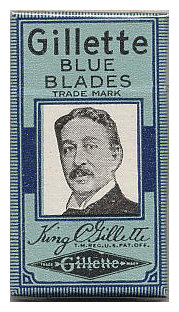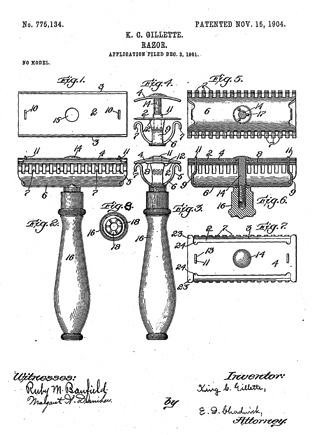 King C. Gillette was inspired to invent the disposable razor by his job as a salesman. He was working for the Crown Cork and Seal Company in the 1890’s selling bottle caps. The inventor of the bottle cap, William Painter, advised Gillette to “invent something people would use and throw away.” Gillette recognized the brilliance of this statement when he saw how successful the Crown Cork and Seal Company had become.
King C. Gillette was inspired to invent the disposable razor by his job as a salesman. He was working for the Crown Cork and Seal Company in the 1890’s selling bottle caps. The inventor of the bottle cap, William Painter, advised Gillette to “invent something people would use and throw away.” Gillette recognized the brilliance of this statement when he saw how successful the Crown Cork and Seal Company had become.
Over the years, Gillette thought of and rejected many possible ideas for disposable products. Then one day, in 1895, he had the idea of producing a safe and disposable razor. When traveling, Gillette would often shave in the bathroom of a train using a safety-razor, which was a heavy blade fit into a wooden handle. This was much safer then using a straight razor but the safety-razor had to be sharpened often and wore out too quickly.
Instead, Gillette wanted to design an inexpensive blade using a piece of steel. The blade could then be replaced easily when it grew dull. For the next six years, Gillette attempted to have such a blade produced. He was told by many experts, including metallurgists at MIT, that it would be impossible to manufacture steel that would be thin, hard and cheap enough.
 Finally in 1901, Gillette met inventor William Nickerson. He agreed to work on producing the needed steel. Nickerson succeed and Gillette applied for a patent. On November 15, 1904, he was granted US Patent 775,134 for a Razor.
Finally in 1901, Gillette met inventor William Nickerson. He agreed to work on producing the needed steel. Nickerson succeed and Gillette applied for a patent. On November 15, 1904, he was granted US Patent 775,134 for a Razor.
Manufacturing began in 1903. Multiples blades and one razor were sold in each package. That first year, the Gillette Safety Razor Company only sold 51 razors and 168 blades. But sales quickly increased and in 1904, he sold 90,884 razors and over 100,000 blades. Manufacturing began outside the US in 1908. The Gillette company began suppling razors to the US Troops in World War I. More than 3 million razors and 30 million blades were given to soldiers. At the end of the war, these men continued to use and purchase the Gillette safety razor.
Over the years, the Gillette company faced fierce competition and patent lawsuits. Many of these were resolved by Gillette buying the competing company. Today, Gillette continues to product razors and other shaving products. More than 600 million people use Gillette products each day.
